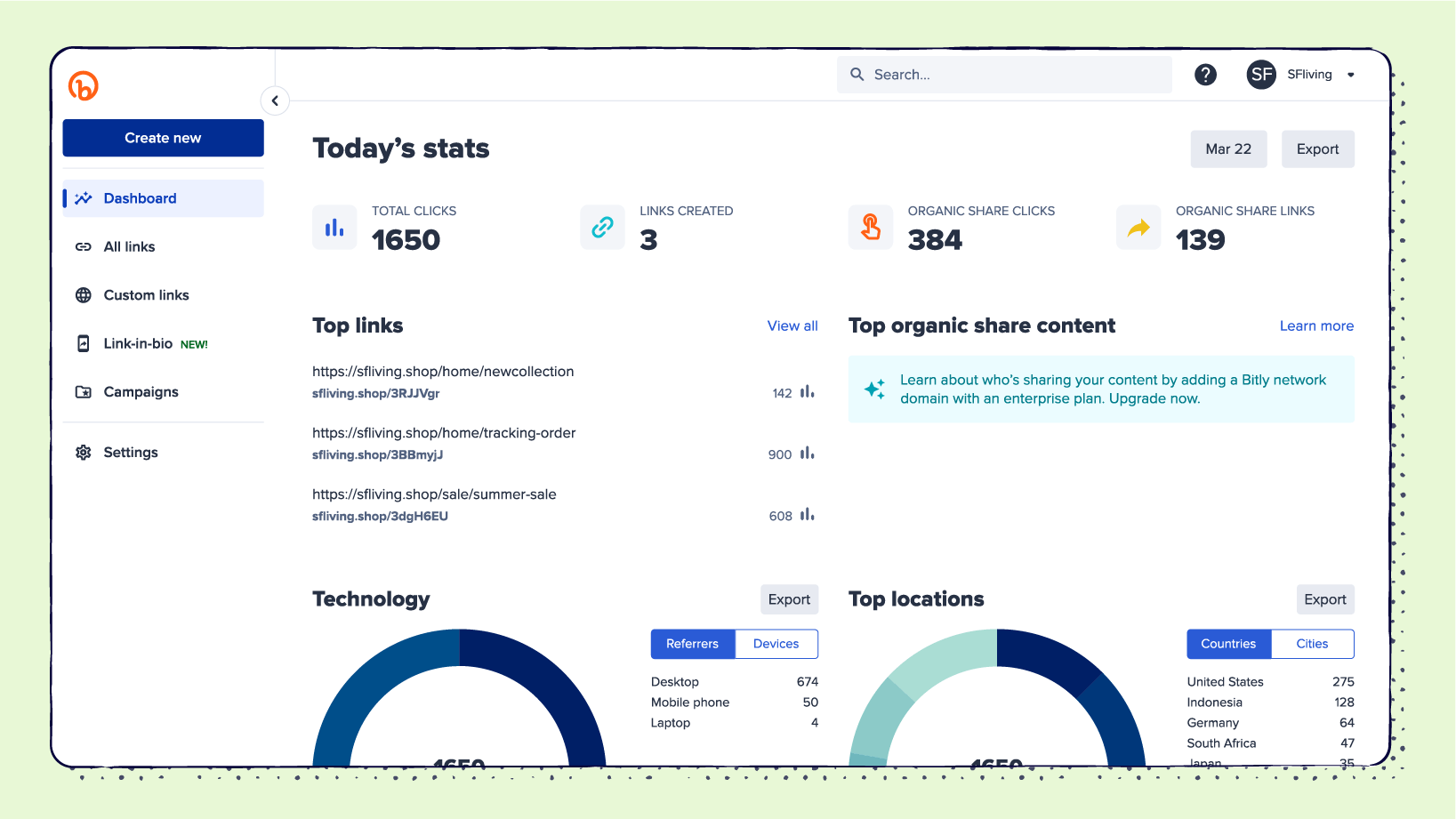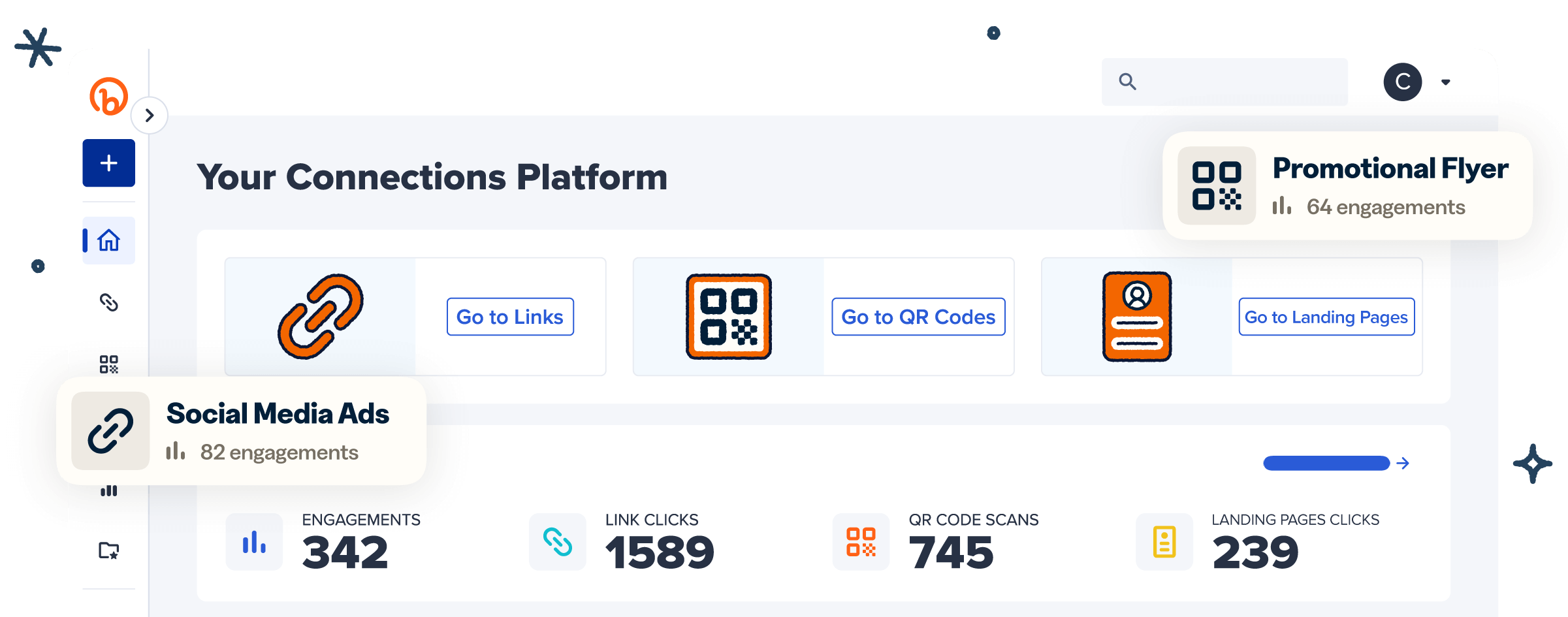Marketers no longer need to rely solely on ad platforms to define who sees their campaigns. With Bitly click tracking and first-party data, you can build precise, custom audiences that reflect real engagement across channels, from social media to email, SMS, and landing pages.
A custom audience is a group of people who’ve interacted with your brand through measurable actions like link clicks or QR Code scans. These audiences help you deliver the right message to the right people, improving conversion rates and campaign performance.
Unlike ad tools that limit visibility, Bitly Analytics gives you secure, real-time insights into audience behavior. With SOC 2 compliance, API integrations, and enterprise-grade governance, Bitly empowers your marketing team to create scalable, privacy-first segmentation strategies that drive better results across every digital marketing channel. This article examines how.
Note: The brands and examples discussed below were found during our online research for this article.
What are custom audiences?
Custom audiences are groups of users built from your own first-party data. They’re collections of people who’ve already interacted with your brand through customer lists, website visits, app activity, link clicks, or QR Code scans. These audiences give marketers a reliable foundation for creating data-driven campaigns that feel personal and relevant.
To free you from relying only on third-party ad platforms like Google or Meta, Bitly click data provides a secure, real-time view of engagement across every digital marketing channel. Each shortlink produced by the Bitly URL Shortener captures valuable metrics such as location (city/country), device type, and UTM tracking referrer, turning every touchpoint into a trackable link that helps refine your marketing strategy.
Many marketers rely on real-time analytics to understand what drives engagement, clicks, and conversions across their digital marketing campaigns. But without the right data connections, those insights can stay fragmented. Bitly bridges that gap by unifying click tracking, QR Code scan metrics, and link performance into a single, centralized view that powers smarter decisions.
By connecting Bitly Analytics to your CRM or marketing automation workflows through the open Bitly API or one of the many pre-built integrations in the Bitly Marketplace, your marketing team can enrich custom audiences with trustworthy insights that drive smarter segmentation, better conversion rates, and consistent results across all marketing campaigns.
After integrating our data into your analytics dashboards, your marketing team can see how each short link or Bitly QR Code performs across social media redirects, email, SMS, print, and paid channels. This integration gives you visibility into campaign performance, audience behavior, and conversion rates, helping you pinpoint what’s driving results and where to optimize.
When enhancing analytics dashboards with Bitly data, our API feeds information directly into tools like Google Analytics, Tableau, or Power BI, and you can layer in UTM parameters, filter by channel, or compare campaigns across time to evaluate true impact.
Where Bitly click data comes from for audience building
Every click, scan, and interaction across your brand’s digital ecosystem holds value. Bitly click data captures these actions in real time, turning them into actionable first-party insights for audience segmentation and campaign optimization. By unifying data across the silos listed below, Bitly helps your team understand exactly where engagement happens and how to build custom audiences that convert.
Links across web, social, SMS, and paid media
Branded short links created through Bitly bring together every marketing channel into one unified attribution layer. Whether shared on a social post, embedded in a paid media campaign, or sent through SMS, each trackable link delivers granular metrics, from click location and device type to referrer and date of use. These data points become audience seeds that reveal where engagement originates and how to refine future campaigns.
Email marketing campaigns
Email remains a powerhouse for digital marketing, with campaigns providing an average ROI of around 40x. Bitly transforms email into a precision targeting tool. Each in-email click generates data about who engages, how often, and with which message types, from product launches to lifecycle promotions. When paired with UTM parameters, Bitly click data helps your marketing team map engagement by cadence, offer type, or customer stage, making it easier to build segmented custom audiences and automate personalized follow-up workflows through your CRM suite or marketing automation platform.
On-site clicks and QR Code scans
Bitly connects online and offline touchpoints through Dynamic QR Codes and embedded Bitly Links. When visitors click a link or scan a QR Code, Bitly captures valuable context like interaction date, device type, and city/country location. This data allows your team to segment audiences by behavioral intent, campaign source, or offline entry point, creating a clear path from physical engagement to measurable digital interactions. Each scan and click feeds into Bitly Analytics, enriching your marketing strategy with real-time, data-driven insights.
Benefits of building custom audiences with Bitly click data
Creating custom audiences from Bitly click tracking gives you complete visibility into who engages, where, and why. Each trackable link and QR Code scan feeds first-party data into a secure, enterprise-grade analytics environment. The result is richer audience quality, smarter activation, and measurable improvement across every digital marketing campaign. You can:
Target with precision based on real engagement
Every click and scan contains high-value signals like referrer, campaign, device type, location, and date, which strengthen audience accuracy. Bitly Analytics helps turn these contextual details into actionable segments, so you deliver relevant content to the right people at the right time.
Improve ROAS and efficiency
When your marketing team builds audiences from real interactions, you eliminate wasted impressions and boost conversion rates. Bitly’s detailed engagement data supports smarter audience inclusions and exclusions, driving higher return on ad spend (ROAS) and more efficient campaign performance.
Test and iterate faster
You can spin up variant audiences by using distinct Bitly Links or Dynamic QR Codes for each creative or offer. This approach enables rapid A/B testing without complicated setup, making it easy to compare audience response by message, design, or promotion and continually optimize based on real-time metrics.
Unify cross-channel attribution
Bitly connects all your marketing channels through consistent UTM parameters and centralized click tracking. Each short link reveals how users move from off-platform engagement to landing pages and conversions, giving you a complete attribution picture that traditional ad platforms can’t match.
Make audience decisions with real-time analytics
Use Bitly’s analytics dashboard and alerts to monitor performance trends and pivot quickly. Your team can track engagement by channel, campaign, or region and use data-driven marketing insights to adjust targeting and creative in real time.
Maintain data hygiene and governance
Enterprise marketers can trust Bitly to manage data governance at scale. Features like branded domains, segmented user access control, and SOC 2 compliance safeguard every workflow. These controls ensure that audience data stays clean, compliant, and ready for automation across CRMs and analytics systems.
Pair Bitly click data with UTMs and analytics platforms
Building accurate custom audiences starts with consistent attribution. When you pair Bitly click tracking with structured UTM parameters and analytics tools like Google Analytics or Google Tag Manager, you create a seamless data flow across marketing channels. This unified approach ensures that every short link, QR Code, and campaign touchpoint contributes to measurable audience insights and better digital marketing performance. Some tips:
Standardize UTMs for clean audience segments
Consistency matters when labeling links. Standardize your UTM content fields across all Bitly Links to maintain clean segmentation. Then, map Bitly link labels to corresponding Google Analytics dimensions so your marketing team can clearly attribute traffic sources and understand audience behavior by channel and campaign. This alignment simplifies workflow automation and keeps metrics reliable for ongoing optimization.
Enrich events with link metadata
Bitly allows you to embed detailed link metadata, such as campaign tags, audience segments, or custom fields, directly into each URL. When this data syncs with your analytics layer or API integration, you gain a deeper view of engagement patterns and conversion rates across channels. Adding Bitly parameters into your Google Analytics or BI platform enables advanced filtering and data-driven decision making, turning every click into an actionable signal for future campaigns.
How to use Bitly click data to create custom audiences
When you unlock audience insights with Bitly’s email integration, you can easily transform Bitly click tracking into actionable custom audiences using a structured workflow. Each stage (link planning → tagging → capture → segmentation → sync/activation) works with the others to build a clear path from engagement to returning customer. By combining first-party data, UTM parameters, and Bitly Analytics, your marketing team can design data-driven campaigns that deliver precision targeting at scale. Let’s look at how to set this all up:
By channel and campaign
Start by creating unique Bitly Links for every marketing channel, campaign, and creative. This setup lets you identify audience seeds based on where engagement happens, whether through email marketing, paid social, display ads, or influencer campaigns. Each trackable link provides granular metrics that reveal which messages, visuals, and placements generate the highest conversion rates.
By geography
Use geo data from Bitly’s click tracking and QR Code scans to localize your audience segmentation. Identify where engagement is strongest, then tailor regional offers, language variants, or store proximity campaigns to those areas. You can optimize digital marketing initiatives by combining location metrics with other insights gleaned from Bitly Analytics for hyper-relevant messaging.
By audience behavior and intent
Segment your audiences by behavioral signals such as content type, product category, and CTA engagement. As you track clicks, you’ll learn where people are in your funnel. For example, clicks on a “Request a Demo” link show high intent, while “View Pricing” clicks indicate buyers in the evaluation stage. Bitly helps map these actions to lifecycle stages, giving your marketing team insights for personalized follow-up workflows and A/B testing.
Sync audiences to CRM and ad platforms
Export audience segments from Bitly and sync them to your CRM suite or ad platforms for retargeting and suppression campaigns. Maintain clean field mapping between systems for metadata like link ID, campaign name, source, and segment, and schedule regular updates to keep audience data fresh. This approach ensures accurate cross-channel attribution and seamless workflow automation.
Governance, security, and compliance (SOC 2)
Your team can protect audience data while scaling operations by taking advantage of Bitly’s built-in security features. Use branded domains to reinforce trust, enable SSO/MFA for access control, and assign role-based permissions for team collaboration. Bitly’s SOC 2 compliance, detailed audit trails, and centralized link management give enterprises confidence that every marketing campaign operates securely, efficiently, and in full compliance.

Build smarter audiences with Bitly click data
Every click, scan, and interaction reveals valuable insights about your audience. By transforming this first-party data into precise custom audiences, your marketing team can improve targeting accuracy, boost activation rates, and increase overall campaign performance.
With Bitly click tracking, you gain unified visibility across social media, email, landing pages, and QR Codes. This setup helps you optimize digital marketing investments and drive measurable revenue impact through smarter segmentation and faster decision-making.
Start building secure, high-performing audiences today. Log in now and see how Bitly click data can elevate your marketing strategy across every channel.




